
Eliseyna Cove is a 3 km wide cove indenting for 1.4 km in the northwest coast of Varna Peninsula between Slab Point to the north and Kotis Point to the south. The cove is named after the Iskar Gorge settlement of Eliseyna in western Bulgaria.

Pomorie Point is a point on the coast of McFarlane Strait forming the north side of the entrance to Lister Cove, Varna Peninsula, Livingston Island in the South Shetland Islands, Antarctica.

Sigritsa Point is an ice-free point on the northeast coast of Varna Peninsula, Livingston Island in the South Shetland Islands, Antarctica forming the northwest side of the entrance to Dragon Cove. The area was visited by 19th century sealers.

Ballester Point is a point forming the south side of the entrance to Johnsons Dock and the northeast side of the entrance to Española Cove in Hurd Peninsula, Livingston Island in the South Shetland Islands, Antarctica. The area was visited by early 19th century sealers operating from Johnsons Dock.

Zornitsa Cove is the 7 km wide cove indenting for 3.1 km the north coast of Livingston Island in the South Shetland Islands, Antarctica. Entered between Rowe Point and Scesa Point on the west side of Ioannes Paulus II Peninsula. Bulgarian mapping in 2009.

Lister Cove is a 2.1 km wide cove indenting for 1.55 km the northeast coast of Varna Peninsula, Livingston Island in the South Shetland Islands, Antarctica south of Pomorie Point and north of Karavelova Point. The cove is fed by Rose Valley Glacier.

Dragon Cove is a 550 m wide cove indenting for 600 m the northeast coast of Varna Peninsula, Livingston Island in the South Shetland Islands, Antarctica entered between Sigritsa Point and Ficheto Point. Surmounted by Sayer Nunatak on the southwest. The area was visited by early 19th century sealers.

Johnsons Dock is a sheltered 500 m wide cove indenting for 900 m the northwest coast of Hurd Peninsula on Livingston Island in the South Shetland Islands, Antarctica. It is part of South Bay entered north of Ballester Point. Surmounted by Charrúa Ridge on the northeast. The cove was frequented by early 19th century sealers.

Sayer Nunatak is a rocky peak rising to 210 m south of Williams Point on Varna Peninsula, at the north edge of the ice cap of Livingston Island in the South Shetland Islands, Antarctica. The nunatak is forming the north extremity of Vidin Heights and surmounting Dragon Cove to the northeast, Griffin Cove to the north-northwest and Charybdis Cove to the southwest.

Polish Bluff is a point forming the southwest side of the entrance to Española Cove and the northeast side of the entrance to Argentina Cove in Hurd Peninsula, Livingston Island in the South Shetland Islands, Antarctica. The area was visited by early 19th century sealers operating from nearby Johnsons Dock.

Henry Bluff is a point forming the southwest side of the entrance to Argentina Cove and the north side of the entrance to Las Palmas Cove in Hurd Peninsula, Livingston Island in the South Shetland Islands, Antarctica. The point is dominated by a prominent monolithic formation rising to 163 m and named El Peñón by personnel of the nearby Spanish Antarctic Base. The area was visited by early 19th century sealers operating from nearby Johnsons Dock.

Sally Rocks is a small group of rocks trending southwestwards in South Bay just off the west coast of Hurd Peninsula, Livingston Island in the South Shetland Islands, Antarctica.

Española Cove is a 1.2 km wide embayment indenting for 250 m the northwest coast of Hurd Peninsula, Livingston Island in the South Shetland Islands, Antarctica. It is part of South Bay entered between Ballester Point and Polish Bluff. The cove is used for the transfer of people and cargo to the Spanish base Juan Carlos I situated at its head. The area was frequented by early 19th century sealers operating from nearby Johnsons Dock.

Argentina Cove is a 1.28 km wide embayment indenting for 330 m the southeast coast of Hurd Peninsula, Livingston Island in the South Shetland Islands, Antarctica. It is part of South Bay, entered between Polish Bluff and Henry Bluff. The area was frequented by early 19th century sealers operating from nearby Johnsons Dock.

Las Palmas Cove is a 1.97 km wide embayment indenting for 500 m the northwest coast of Hurd Peninsula on Livingston Island in the South Shetland Islands, Antarctica. It is part of South Bay, Livingston Island entered between Henry Bluff and Salisbury Bluff. The area was visited by early 19th century sealers operating from nearby Johnsons Dock. It also where the Las Palmas Glacier terminates.

Slab Point is a rocky point on the northwest coast of Varna Peninsula, Livingston Island in the South Shetland Islands, Antarctica forming the north side of the entrance to Eliseyna Cove and the south side of the entrance to Charybdis Cove.

Gargoyle Bastion is a rocky headland rising to 60 m on the northwest coast of Varna Peninsula, Livingston Island in the South Shetland Islands, Antarctica and forming the south side of the entrance to Hydra Cove and the northeast side of the entrance to Griffin Cove. It has sub-vertical cliff faces to seaward, and is flanked to north and south by rock cliffs.

Charybdis Cove is the 1.2 km wide cove indenting for 580 m the northwest coast of Varna Peninsula, Livingston Island in the South Shetland Islands, Antarctica and entered between Organpipe Point to the north and Slab Point to the south.

Griffin Cove is the 800 m wide cove indenting for 260 m the northwest coast of Varna Peninsula, Livingston Island in the South Shetland Islands, Antarctica and entered between Gargoyle Bastion to the northeast and Organpipe Point to the southwest.








